Page 126 of 324
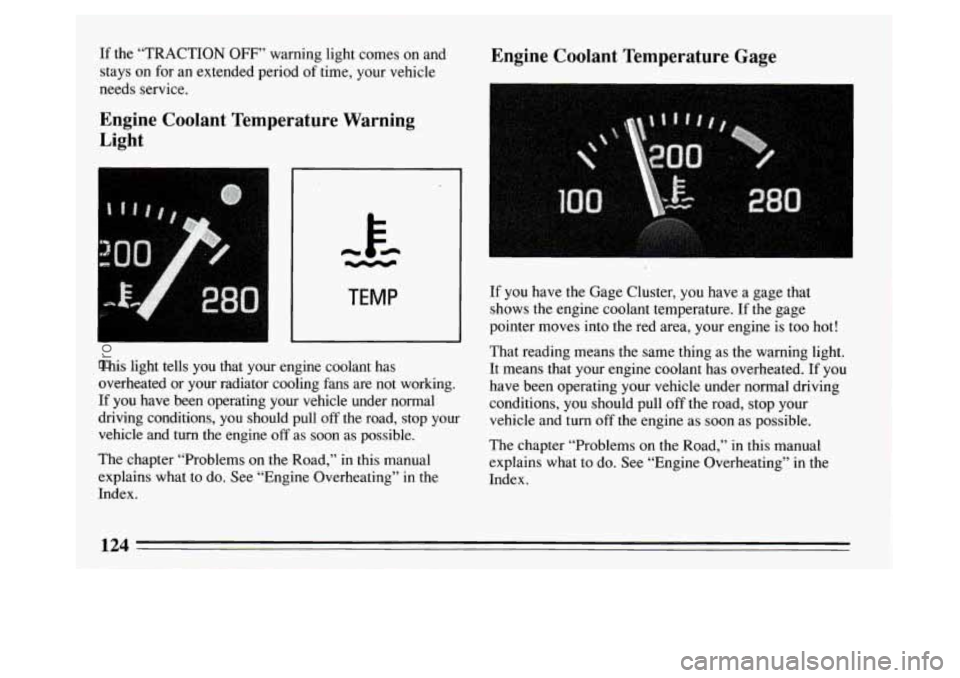
Engine Coolant Temperature Gage If the “TRACTION OFF” warning light comes on and
stays on for an extended period of time, your vehicle
needs service.
Engine Coolant Temperature Warning
Light
TEMP
This light tells you that your engine coolant has
overheated or your radiator cooling fans are not working.
If you have been operating your vehicle under normal
driving conditions, you should pull
off the road, stop your
vehicle and turn the engine
off as soon as possible.
The chapter “Problems on the Road,” in this manual
explains what to do. See “Engine Overheating” in the
Index.
If you have the Gage Cluster, you have a gage that
shows the engine coolant temperature.
If the gage
pointer moves into the red area, your engine is too hot!
That reading means the same thing as the warning light.
It means that your engine coolant has overheated. If you
have been operating your vehicle under normal driving
conditions, you should pull
off the road, stop your
vehicle and
turn off the engine as soon as possible.
The chapter “Problems on the Road,” in this manual
explains what to do. See “Engine Overheating” in the
Index.
124
ProCarManuals.com
Page 127 of 324
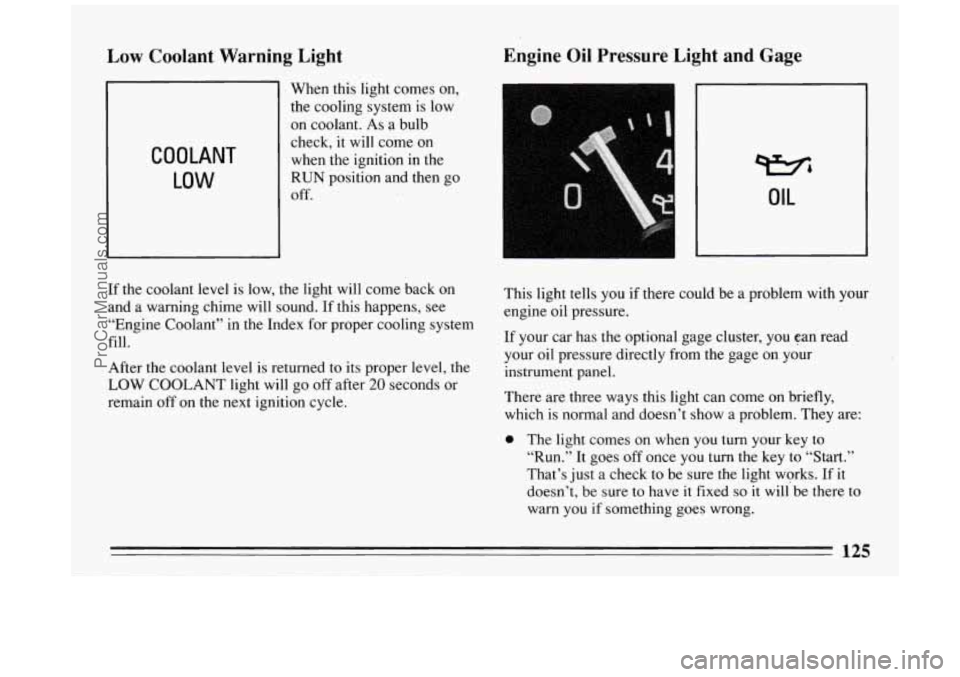
Low Coolant Warning Light Engine
Oil Pressure Light and Gage
COOLANT
LOW
When this light comes on,
the cooling system is low
on coolant. As a bulb
check, it will come on
when the ignition in the
RUN position and then go
Off.
Wb
OIL
If the coolant level is low, the light will come back on
and
a warning chime will sound. If this happens, see
“Engine Coolant’’ in the Index for proper cooling system
fill.
After the coolant level is returned to its proper level, the
LOW COOLANT light will go off after 20 seconds or
remain off
on the next ignition cycle. This
light
tells you if there could be a problem with your
engine oil pressure.
If your car has the optional gage cluster, you can read
your oil pressure directly from the gage on your
instrument panel.
There are three ways this light can come on briefly,
which
is normal and doesn’t show a problem. They are:
0 The light comes on when you turn your key to
“Run.”
It goes off once you turn the key to “Start.”
That’s just a check
to be sure the light works. If it
doesn’t, be sure
to have it fixed so it willbe there to
warn you if something goes wrong.
125
ProCarManuals.com
Page 135 of 324
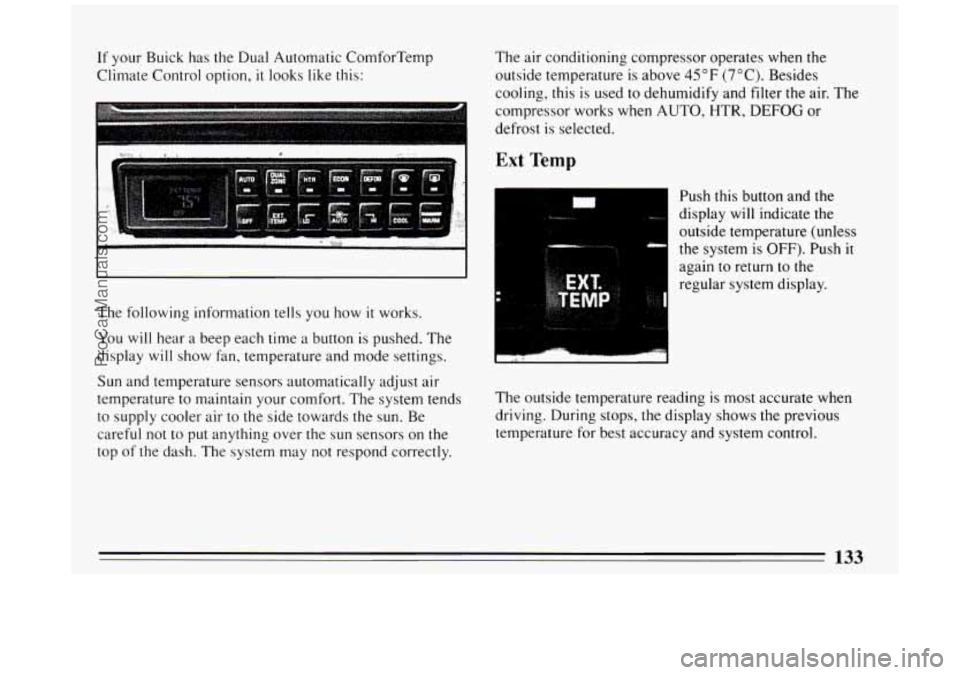
If your Buick has the Dual Automatic ComforTemp
Climate Control option,
it looks like this: The air conditioning compressor operates
when
the
outside temperature is above 45°F (7°C). Besides
cooling, this is used to dehumidify and filter
the air. The
compressor works when AUTO, HTR, DEFOG or
defrost is selected.
The following information
tells you how it works.
You
will hear a beep each time a button is pushed. The
display
will show fan, temperature and mode settings.
Sun and temperature sensors automatically adjust air
temperature to maintain your comfort. The system tends
to supply cooler air to the side towards the sun. Be
careful not to put anything over the sun sensors on the
top
of the dash. The system may not respond correctly.
Ext Temp
Push this button and the
display will indicate the
outside temperature (unless
the system
is OFF). Push it
again to return to the
regular system display.
.. * '' I
The outside temperature reading is most accurate when
driving. During stops, the display shows
the previous
temperature for best accuracy and system control.
133
ProCarManuals.com
Page 136 of 324
CoollWarm Off
To adjust the temperature to a comfortable level, push
either
COOL or WARM.
You can choose a temperature between 60 OF ( 16 O C) for
maximum cooling, and
90" F (33°C) for maximum
heating. It is not necessary to choose the extreme
temperature
to get the system to heat or cool at the
maximum. The system does
it automatically. When the
system
is OFF, the ventilation system will
allow air to flow through your Buick when the vehicle is
moving.
The system
will try to keep the air at the chosen
temperature. The outside temperature will show
in the
display area unless the system is
OFF.
134
ProCarManuals.com
Page 139 of 324
If you want the blower fan
to run at a lower speed,
push the
LO button. The
blower speed
will decrease
with every push of the
button
until the lowest
speed is reached.
If you want to raise the
blower speed, push
HI. The
blower speed
will increase
with every
push of the
button
until maximum
speed
is reached.
Econ
You can use ECON when
you don’t need to cool the
outside air. The system will
work like the AUTO mode
without cooling. The air
flow
will come from the
instrument panel outlets.
ECON does not have the
blower delay feature as
the
AUTO mode setting.
This setting turns off the air conditioner allowing better
fuel economy.
Heater
To warm the air, press mR
and adjust the temperature
and fan speed for your
comfort. Most of the air
will come from the floor
outlets.
137
ProCarManuals.com
Page 142 of 324
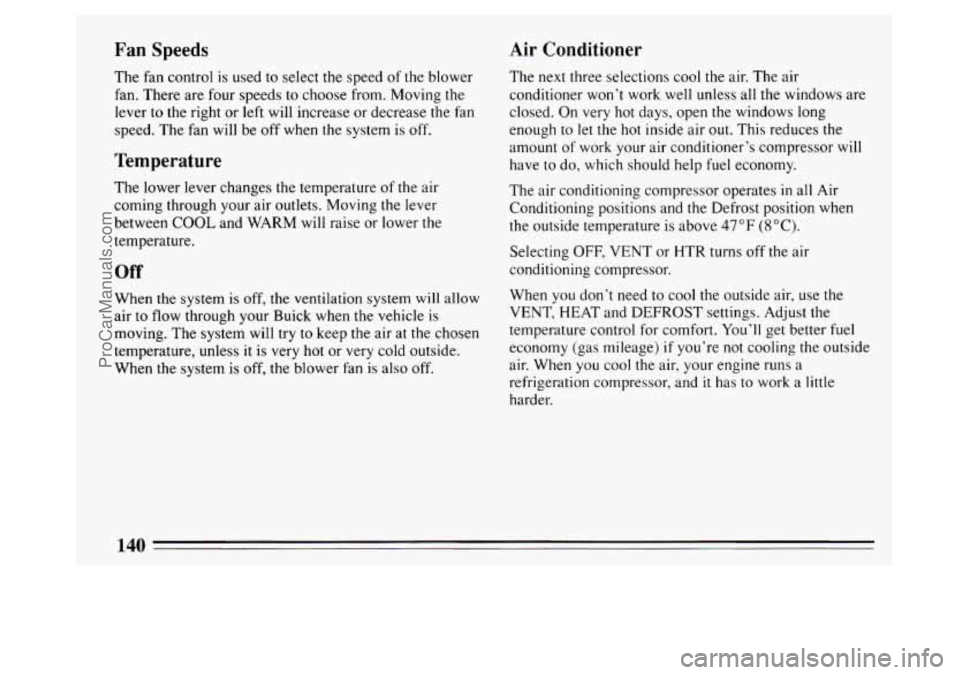
Fan Speeds Air Conditioner
The fan control is used
to select the speed of the blower
fan. There are four speeds to choose from. Moving the
lever to the right or
left will increase or decrease the fan
speed. The fan will be off when the system is
off.
Temperature
The lower lever changes the temperature of the air
coming through your air outlets. Moving the lever
between
COOL and WARM will raise or lower the
temperature.
Off
When the system is off, the ventilation system will allow
air to
flow through your Buick when the vehicle is
moving. The system will try to keep the air at the chosen
temperature, unless
it is very hot or very cold outside.
When the system is off, the blower fan is also off. The
next three selections cool the air. The air
conditioner won’t work well unless all the windows are
closed. On very hot days, open the windows long
enough to let the hot inside air out. This reduces the
amount of work your air conditioner’s compressor
will
have to do, which should help fuel economy.
The air conditioning compressor operates
in all Air
Conditioning positions and
the Defrost position when
the outside temperature
is above 47°F (SOC).
Selecting OFF, VENT or HTR turns off the air
conditioning compressor.
When you don’t need to cool the outside air, use the
VENT, HEAT and DEFROST settings. Adjust the
temperature control for comfort. You’ll get better fuel
economy (gas mileage)
if you’re not cooling the outside
air. When you cool the air, your engine runs a
refrigeration compressor, and
it has to work a little
harder.
140
ProCarManuals.com
Page 143 of 324
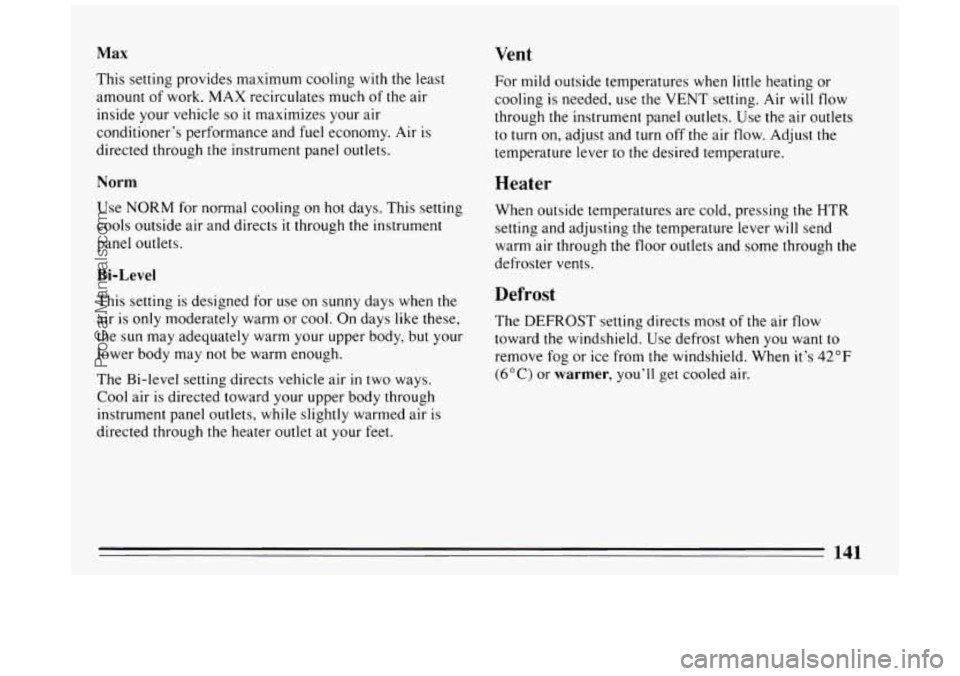
Max Vent
This setting provides maximum cooling with the least
amount
of work. MAX recirculates much of the air
inside
your vehicle so it maximizes your air
conditioner’s performance and fuel economy. Air is
directed through
the instrument panel outlets.
Norm
Use NORM for normal cooling on hot days. This setting
cools outside air and directs
it through the instrument
panel outlets.
Bi-Level
This setting is designed for use on sunny days when the
air is only moderately warm or cool. On days like these,
the sun may adequately warm your upper body, but your
lower body may not be warm enough.
The Bi-level setting directs vehicle air
in two ways.
Cool air
is directed toward your upper body through
instrument panel outlets, while slightly warmed air is
directed through the heater outlet at your feet. For
mild outside temperatures when little heating or
cooling is needed, use the VENT setting. Air
will flow
through the instrument panel outlets. ,Use the air outlets
to turn
on, adjust and turn off the air flow. Adjust the
temperature lever to the desired temperature.
Heater
When outside temperatures are cold, pressing the HTR
setting and adjusting the temperature lever
will send
warm air through
the floor outlets and some through the
defroster vents.
Defrost
The DEFROST setting directs most of the air flow
toward the windshield. Use defrost when you want
to
remove fog or ice from the windshield. When it’s 42°F
(6°C) or warmer, you’ll get cooled air.
ProCarManuals.com
Page 185 of 324
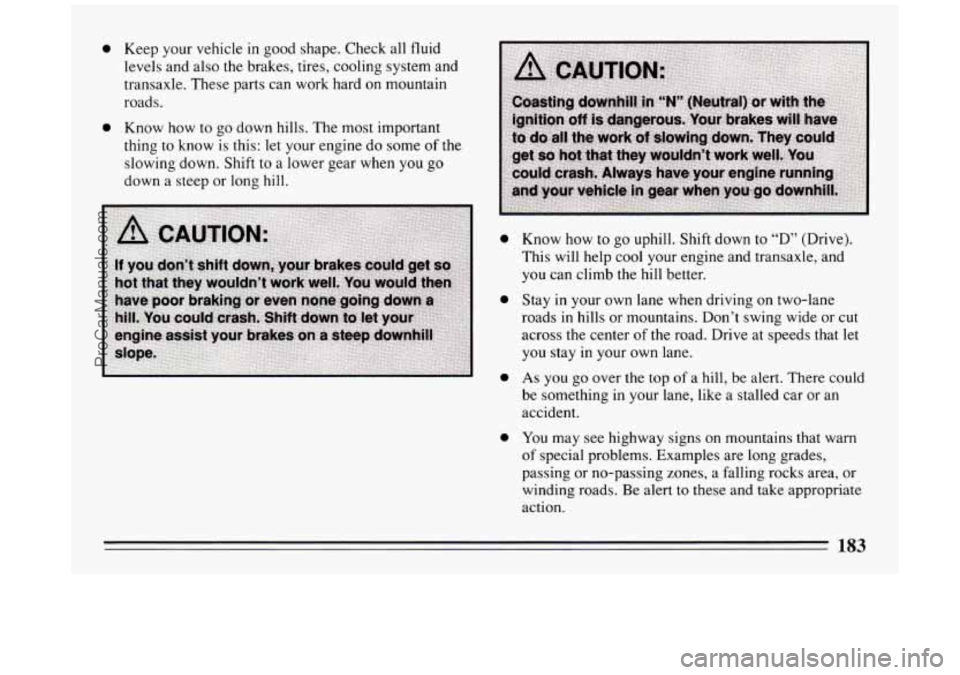
0 Keep your vehicle in good shape. Check all fluid
levels and also the brakes, tires, cooling system and
transaxle. These parts can work hard on mountain
roads.
0 Know how to go down hills. The most important
thing
to know is this: let your engine do some of the
slowing down. Shift to
a lower gear when you go
down a steep or long hill.
0
0
0
0
Know how to go uphill. Shift down to “D” (Drive).
This will help cool your engine and transaxle, and
you can climb the hill better.
Stay
in your own lane when driving on two-lane
roads
in hills or mountains. Don’t swing wide or cut
across the center
of the road. Drive at speeds that let
you stay in your own lane.
As you go over the top of a hill, be alert. There could
be something in your lane, like a stalled car or an
accident.
You may see highway signs on mountains that warn
of special problems. Examples are long grades,
passing or no-passing zones, a falling rocks area, or
winding roads. Be alert
to these and take appropriate
action.
183
ProCarManuals.com